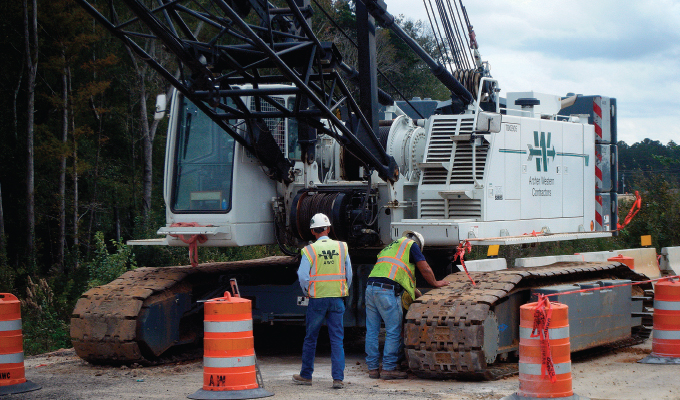By Debbie Dickinson
Signing a standard crane rental agreement attests to so much more than simple acknowledgement of the date and time of the crane’s arrival, and if included, the operator. When a general contractor rents a crane, the rental is typically for either a Bare Rental without an operator or a Manned and Maintained Rental, which includes the provision of an operator. The first signature line can bind the entity to the terms and conditions of the crane rental. Crane rental companies spell out terms so that everyone involved is aware of who is responsible for what.
For one, renting a crane does not eliminate general contractor responsibility for the safety of the site and the crane operation. In fact, OSHA 1926.1402 states that ground conditions are the responsibility of the controlling entity, which is often the GC. This includes preparing the ground for crane travel and/or work and providing the crane rental company with information about any hazards on access roads and crane pad setup area. The crane rental company can also be a valuable resource in helping contractors comply with the terms of the crane rental contract.
Barry Garrett, with Maxim Cranes in Atlanta, explains: “We provide the ground pressure bearings of the cranes to our customers so that both the customer and Maxim Crane has a better idea of what is needed to support the crane, while moving in on a site, and during the lifting process. If the cranes need additional matting, we also provide materials to support either the tracks on crawler cranes or outriggers on large hydraulic cranes. This, of course, is vital information needed to ensure and maintain the safety of the project.”
PERSONNEL QUALIFICATIONS
If the crane rented by the GC will be used by any of the subcontractors, an additional agreement needs to be in place between the crane users and the GC. General contractors should avoid taking on the responsibilities that are the responsibilities of the entities using the crane. The GC should, however, require every subcontractor using the crane to be OSHA compliant and submit proof of certifications and qualifications of the employees using and directing crane work.
Typically, subcontractors will provide the riggers and signalpersons. Most crane operators, even those supplied with a manned and maintained rented crane, work at the direction of others. Rarely is the crane operator directing the work. Therefore, it’s a good practice to verify the qualifications of the lifting crew, including the crane operator, even when supplied with a manned and maintained rental.
For a manned and maintained rental, the rental company should provide a certified crane operator; but certified does not equal qualified. Certification meets a national standard and is a federal requirement. Qualification is specific to the particular crane, task involved, and the work environment. Yes, if certified, the operator can operate a crane. The question now becomes, can the operator operate this crane? Who is attesting to that fact?
In addition, a crane rented by the GC that will be used by subcontractors also assumes that the subcontractors will supply the riggers or signalpersons. The responsibility of supplying qualified riggers and signalpersons should not belong to the GC. However, if the GC’s company rep signs the agreement, make sure the subcontractors using the crane are only utilizing qualified individuals.
RECEIVING THE CRANE
The crane that has been rented will most likely be in good operation condition, but the GC should still verify that before accepting receipt of the crane. Inspection can be done by a qualified supervisor, or an alternative is to hire a third-party inspector. Often the crane rental company can recommend someone. Good inspectors are insured, can conduct Non-Destructive Testing, are certified operators and riggers themselves, and are competent to inspect, qualify and provide the necessary documentation. If any deficiencies are found that would prohibit safe crane operation, those must be corrected before work begins.
Regarding crane operator qualification, the GC’s supervisor or a third-party should test and document the qualification of the certified operator on the rented machine. Certification should match the machine type. Operator’s credentials can be verified online or by the card the operator carries.
GETTING LIFT READY
Normally, crane rental companies do not provide rigging gear or suggest which gear should be used for a particular lift, unless doing so is specified in the sales agreement. A crane rental company may have rigging on board the crane and will allow the riggers to use it, but the responsibility for selecting the proper rigging gear is the responsibility of the rigger and/or their company.
It’s a good idea to require subcontractors to perform and document pre-lift meetings between the crane operator(s) and the ground crew. In addition to OSHA requirements for qualified riggers and signalpersons, usually the crane rental contract spells out that the entity renting the crane is responsible for providing qualified riggers and signalpersons. This responsibility should be actively passed on to the subcontractors.
CLOSING THOUGHT
These practices help keep people, equipment, and the jobsite all working and remaining in good operating condition. To keep job schedules on time, work with a reputable, trustworthy company. A knowledgeable crane rental representative will help select the right crane for the job and advise you when to start the rental, based on the work and job timing. Every responsibility mentioned takes time and planning.
About the Author:
Debbie Dickinson is CEO of Crane Industry Services LLC, (CIS). CIS provides hands-on, classroom and simulation-based training for the crane and rigging industry, ANSI-accredited NCCER and NCCCO certifications, equipment inspections, expert witness services, and consulting to the lifting industry. CIS is a certified Woman Owned Small Business. For more, visit www.centeredonsafety.com.
Modern Contractor Solutions, October 2021
Did you enjoy this article?
Subscribe to the FREE Digital Edition of Modern Contractor Solutions magazine.



